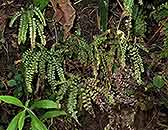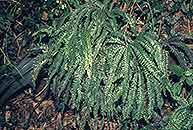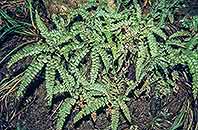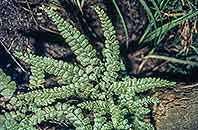Adiantum hispidulum Sw. var. hispidulum
Synonyms |
Adiantum lindsaea Cav. |
|---|---|
Common name |
|
Description |
Rhizome short, erect to creeping, 1-2 mm in diameter; rhizome scales lanceolate in outline, entire, reddish to dark brown. Fronds monomorphic, tufted, erect. Stipe up to 30 cm long, thin, chestnut-brown to black, shining, covered with short, brown, stiff hairs, brown scales scattered near base. Lamina deltate in outline, 24 × 20 cm, undersurfaces covered with short white hairs, pedately or repeatedly dichotomously divided into up to 8 (7-15) pinnate pinnae; pinnae up to 15 cm long, longest in the centre, the others decreasing outwards; pinnules numerous, persistent, subrhombic to rectangular becoming smaller toward the pinna apex, 5-17 × 3-8 mm, pinnules with short petiole (0.5-1 mm long), pale hairs along the margin, upper and outer margins irregularly toothed, lower margin entire and ascending; rhachis with bristly hairs. Sori numerous, rounded, on pinnule lobes on the upper and outer margin of the undersurface of a hairy indusial flap. |
Notes | A. hispidulum is pedately or unequaly dichotoom divided. It can be distinguished from A. patens which is glabrous and has a broad terminal segment at the end of each segment. |
Derivation | hispidulum: covered with minute stiff erect hairs |
Habitat | Around boulder basis in woodland or banks, grassy places, rocky areas and near waterfalls in forest. |
Distribution worldwide | Southern and East Africa; also Indian Ocean Islands, Azores (naturalized), India, Taiwan, Malaysia, Indonesia, Australia, Norfolk I., New Zealand, Polynesia. |
Distribution in Africa |
Kenya, Malawi, Mozambique, South Africa, Tanzania , Zimbabwe. |
Growth form |
Terrestrial. |
Literature |
|



